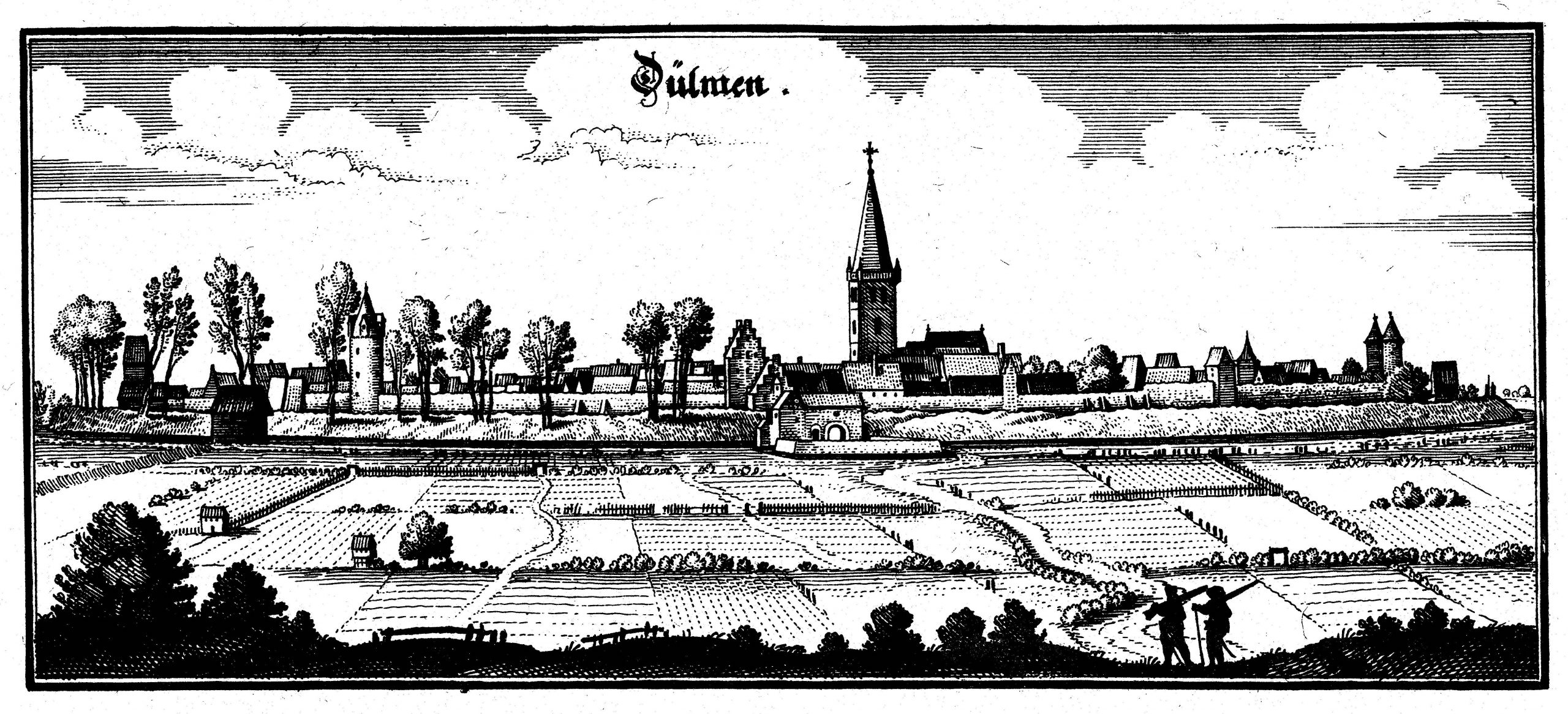Dülmen – a general overview
A print of a facsimile from Matthaeus Merian from the book “Topograhia Germaniae”. The view of Dülmen is from the middle of the 17th Century.
The town of Dülmen, reached by the A 43 motorway from Münster to Recklinghausen, is the biggest in the Coesfeld district. The very favourable traffic situation makes the town a connecting link between Münsterland and the Ruhrgebiet. The old town towers are the last witnesses of a century-old history which experienced a deep cut in the total destruction in March 1945 at the end of the war.
A parish probably already existed in the year of the death of Saint Liudger, 809, the first bishop of Münster. In 1311 Dülmen received the rights of a town from Bishop Ludwig II. Besides self-administration among these rights were market and wall rights.
In 1323 the parish church St. Viktor was elevated to a seminary church. The capital paid for a dean in charge of twelve canons.
In 1623 during the Thirty Years War Dülmen had to open its gates to the troops of the Kaiser. The town rule since 1311 thus came to an end. In 1629 a great fire burnt down almost a third of the town and damaged the town walls and gates. Only after a long, hard period of occupation did the army from Hesse finally leave the town.
During the Seven Year War the town lost the fortification ring. The French commander had the major part of the old town walls pulled down. The towers remaining today come from the time around 1500.
With the annexation of Münsterland in the French empire in 1811, Napoleon cancelled the capital to St. Viktor and the Augustinian monastery Agnetenberg in Dülmen. As a new ruler the Prussian king transferred Dülmen to the Coesfeld district in the Westphalian province.
In 1878, as Bernhard Thonemann became resident in Dülmen by his marriage, the town had about 5000 inhabitants. Bernhard died in 1926. In those 48 years, the town increased its population from about 4266 to 9266. Today, 1994, Dülmen has about 43000 inhabitants.
The town was not able to maintain its historical face due to the severe war damage. However an unusually powerful reconstruction, which was able to connect traditional structures and values with modern requirements harmoniously, had the town rebuilt on the old place with a new face. The consciousness of home, the hard work and the reliability of the Münsterland people provided the guarantee in the reconstruction for a continual upwards development.
Truly, there are not many more regions in our great Germany which distinguish themselves by a clear structure with clear contours, have an uninterrupted relationship to their history and traditions, where we meet the pretty villages and towns people with straight and honest characters and handed down values; a country with green meadows, interspersed with moors, with relieving hedges, also shaded woods, many strong, sedate, partly gnarled oaks, which surround the farmhouses decorated with flowers and particularly the castles with moats and last but not least a species which does not exist in any other part of Europe: wild horses in Merfelder Bruch; a flat and broad land with its own appeal, which Goethe called simply “the grandeur of the plain”. Quality of life which so many people appreciate so very much.
